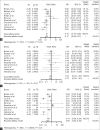EUS-guided versus percutaneous transhepatic cholangiography biliary drainage for obstructed distal malignant biliary strictures in patients who have failed endoscopic retrograde cholangiopancreatography: A systematic review and meta-analysis
- PMID: 35083977
- PMCID: PMC8887045
- DOI: 10.4103/EUS-D-21-00009
EUS-guided versus percutaneous transhepatic cholangiography biliary drainage for obstructed distal malignant biliary strictures in patients who have failed endoscopic retrograde cholangiopancreatography: A systematic review and meta-analysis
Abstract
EUS-guided biliary drainage (EUS-BD) and percutaneous transhepatic cholangiography biliary drainage (PTC) are the two alternate methods for biliary decompression in cases where ERCP fails. We conducted a systematic review and meta-analysis of studies to compare the efficacy and safety of endoscopic and percutaneous biliary drainage for malignant biliary obstruction in patients with failed ERCP. A total of ten studies were included, fulfilling the inclusion criteria, including four retrospective studies and six randomized controlled trials. We compared the technical and clinical success rates and the acute, delayed, and total adverse events of EUS-BD with PTC. The odds ratios (ORs) and confidence intervals (CIs) were calculated. There was no difference between technical (OR: 0.47 [95% CI: 0.20-1.07]; P = 0.27) and clinical (OR: 2.24 [95% CI: 1.10-4.55]; P = 0.51) success rates between EUS-PD and PTC groups. Procedural adverse events (OR: 0.17 [95% CI: 0.09-0.31]; P = 0.03) and total adverse events (OR: 0.09 [95% CI: 0.02-0.38]; P < 0.01) were significantly different between the two groups; however, delayed adverse events were nonsignificantly different (OR: 0.73 [95% CI: 0.34-1.57]; P = 0.97). This meta-analysis indicates that endoscopic biliary drainage (EUS-BD) is equally effective but safer in terms of acute and total adverse events than percutaneous transhepatic biliary drainage (PTC) for biliary decompression in patients with malignant biliary strictures who have failed an ERCP.
Keywords: EUS-guided biliary drainage; confidence intervals; endoscopic retrograde cholangiopancreatography; malignant biliary strictures; malignant obstructive jaundice; meta-analysis; odds ratios; percutaneous transhepatic cholangiography.
Conflict of interest statement
None
Figures



References
-
- Kurniawan J, Hasan I, Gani RA, et al. Mortality-related factors in patients with malignant obstructive jaundice. Acta Med Indones. 2016;48:282–8. - PubMed
-
- Khashab MA, Dewitt J. EUS-guided biliary drainage: Is it ready for prime time? Yes! Gastrointest Endosc. 2013;78:102–5. - PubMed
-
- Enochsson L, Swahn F, Arnelo U, et al. Nationwide, population-based data from 11,074 ERCP procedures from the Swedish registry for gallstone surgery and ERCP. Gastrointest Endosc. 2010;72:1175–84e1-3. - PubMed
-
- Giovannini M, Bories E, Napoleon B, et al. 855 multicenter randomized phase II study: Percutaneous biliary drainage vs. EUS guided biliary drainage: Results of the intermediate analysis. Gastrointest Endosc. 2015;81:AB174.

